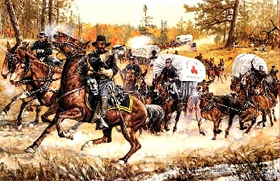7-13 October 1863
Medal of Honor - Civil War
In the fall of 1863 after the Battle of Gettysburg, the Federal army moved back into Virginia, establishing headquarters in Culpepper. Soon Lee’s Confederates were on the march again, threatening Washington.
 On October 10th and 11th Confederates advanced across the Rapidan to cut the Union army’s lines to the capital. While the rest of the army fell back toward Washington, over 4,000 six-mule wagons filled with forage, clothing, equipment and food for the army were put under the command of LTC Richard N. Batchelder, Chief Quartermaster for the Second Corps.
On October 10th and 11th Confederates advanced across the Rapidan to cut the Union army’s lines to the capital. While the rest of the army fell back toward Washington, over 4,000 six-mule wagons filled with forage, clothing, equipment and food for the army were put under the command of LTC Richard N. Batchelder, Chief Quartermaster for the Second Corps.
Over dirt roads and wilderness hills, the vulnerable caravan plodded on, day and night, from 13-15 October. The army could afford no escort, so Batchelder armed his teamsters. The fierce Confederate raider John Mosby and his partisan rangers struck frequently and violently, but LTC Batchelder personally commanded his men in fighting them off, thus saving the Army of the Potomac’s vital supplies
For his valor LTC Batchelder was awarded the Medal of Honor, and the event itself was preserved in the painting Lifeline to Victory by renowned Civil War artist Don Stivers.
More information on Medal of Honor Recipient LTC Richard Batchelder
Compiled by Dr. Steven Anders, former Quartermaster School historian.
Quote of the Week:
The history of war proves that nine times out of ten an army has been destroyed because its supply lines have been cut off.— General Douglas MacArthur
(25 September 1950)
